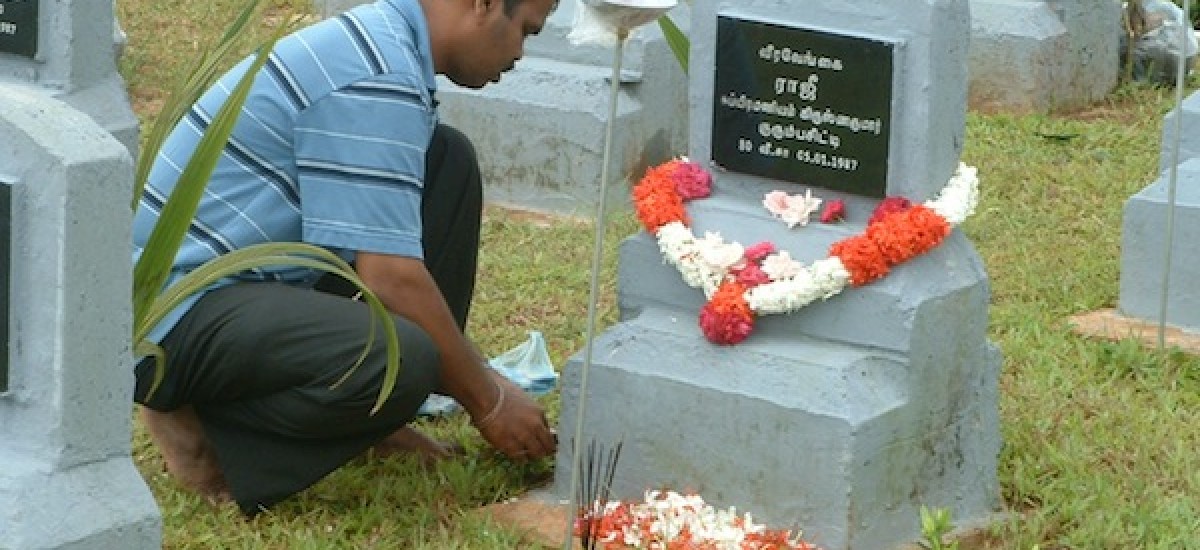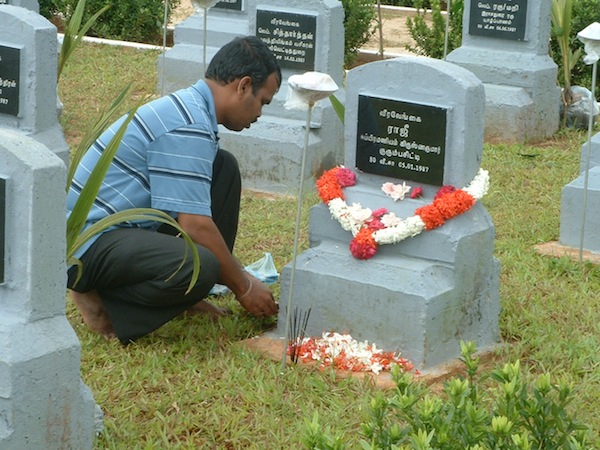[Author’s note: Though I was invited around February 2011 to respond to the discussion in Groundviews on the issue of Tiger ‘cemeteries’ being desecrated, I was so busy that my draft article simply stayed as draft and got lost in the computer debris. I was simply overloaded with cricket and other vital issues during March-April. Having discovered the draft, I present it with apologies.]
Some sections of the Tamil intelligentsia remain biter and defiant today after the demise of their plans for national self-determination. “We are a defeated people,” said one articulate professional in the Jaffna Peninsula in June 2010 in an unsolicited remark that conveyed his defiance.
The heavy presence of security forces and the proportion of land occupied by the various arms of state power in the northern reaches were among the grievances throbbing in the hearts of those hostile to the new dispensation (a body whose proportions I am in no position to assess). Thus, the HSZ spaces and the many buildings that had been commandeered by the three armed services since 1995 and 2009 remained a bone of contention when I was in the Lanka in 2010.
The government is not blind to these sentiments. It has periodically reduced goblets of its territorial tentacles and proclaimed these steps far and wide. One of the army’s ‘acquisitions’ was the old Subash Hotel in Jaffna town which had been turned into the local Army HQ. So, it was with some implicit breast-beating that the government recently told the world that the “new headquarters of the 51st Brigade of the Army [had been] opened on the Koppai Cemetery ground” on the 4th March and that they were in the process of vacating Subash Hotel.[1]
Koppai was one of many tuyilam illams, or “sleeping houses,” built by the LTTE to commemorate their māvīrar or “great heroes” (also translated loosely as “martyrs”). In terms of the Tamil cultural classifications the translation of this term as “cemeteries” may be a misnomer, but one should not be too pedantic on this point. Likewise, it is possible that many epitaphs did not contain any remains.
My criticism[2] of the government’s obliteration of the LTTE”s tuyilam illam was directed along two paths: (A) that it was an act of desecration and “not done”’ and (B) that it was unintelligent politics in the sense that the epitaphs could highlight the LTTE”s folly rather than serving as an inspiration for rejuvenation, while their obliteration could also activate sentiments of vengeance. The second line of reasoning spelt out above is a form of instrumental pragmatic reasoning.
Sarvananthan has questioned my argument in amiable style by emphasizing that the tuyilam illam were monuments of commemoration not “real” cemeteries with the remains of the dead. There are no remains, so there is no desecration.
I am not in a position to question the empirical basis of his assertion, though I would be surprised if this was true of all individual sites in all tuyilam illam. What impresses me is Sarvananthan’s bravery, both now and in the recent past. Sarvananthan was a Tamil dissident in the Tiger era, refusing to toe their line and yet forging a path that was singular, a road that did not lock him into the crusading parameters of CPA, ICES, NPC et cetera. In this sense he was, and remains, a lone ranger.
In this particular intervention he is a lone ranger who cleaves to paths secular and positivist. Indeed, he is radically and wholly positivist: there are no remains in the tuyilam illam, so there is no desecration.
My challenging query to his empiricist extremism is to ask whether the individual epitaphs at tuyilam illam which were visited by Tamil kinfolk during the LTTE era were empty of meaning? The point is that such gravestones drew lament and bodily collapse from some of the living relatives.[3] These were deeply subjective moments, these visits. During Māvīrar Nāl, of course, the lighting of lamps and expressions of grief were magnified by the mass emotions aroused by that day.[4] The fact that the occasion was choreographed by the LTTE does not mean that its political and individual depth of sentiment was any less significant.
It is because of my attentiveness to this context of heartfelt meaning that I criticized the obliteration operation. But in speaking of unethical practice, I was aware that I was abiding by a relatively modern code established in Europe and was attentive to the problem of treating this evaluation as a universal yardstick. I also elaborated upon the Sinhalese cultural logic of fragmenting the body of the Enemy Other in punishments that would have ramifying effects in the future lives of those punished as well as all their kinfolk. The understanding among some Sinhalese is that the fragmented person will transform into a perētayā (spirit) and render miserable the lives of kinspersons in the present world.
Thus, the ancient kingly practice of dismembering the bodies of criminals and traitors was an imprint of power with a message for the populace that gained greater force because of the awesome ramifications of such an act in the afterlife and this life of relatives and punished.[5] When JVP activists in the deep-south took an individual deemed to be traitor to a crossroads at midnight and cut him into pieces as deadly punishment they were guided by the same logic.[6] When a working class woman propitiates a deity and asks him to inflict an errant husband with eczema and smallpox, she is also abiding by this mode of punishment.[7] Whether this line of thinking directed the government’s act of bulldozing the tuyilam illam I cannot say; but it is a possibility that one must keep in mind.
My essay on “Symbolic Postscript: A Terrible Violence” was presented in late 2009 when the war had just been won. But we are now in the Now, we are sitting, happily or unhappily, in 2011. The Now moves me closer to Sarvananthan’s position. The tuyilam illam are no more. They are vacant lots and there no individual gravestones. They are, arguably but controversially, like that Dutch cemetery in Galle whose epitaphs have been moved to the Presbyterian Church in the Fort so that contemporaries can get on with the utilization of valued space.
Thus I ask: once a tuyilam illam have been done and dusted, does it remain a tuyilam illam? My move here is pragmatic and in this sense is in the Sarvananthan realm. Should we not focus on moving on?
To those revengeful Tamils who are attached to the power of the deities and reside in realms of cosmic power there may even great hope in this act of the Sri Lankan army. From such a cosmic perspective anyone residing on top of so many māvīrar invites māvīrar perētayō to enter their personal spaces and wrought havoc upon body and mind. The Army HQ, in other words, has opened its intestines to serious demonic attack. Amen.
Photos taken by the author in Poppai in November 2004.
[1] Since this was announced earlier in the year some more HSSZ lands have been handed back to the civil order and hopefully to their original owners.
[2] http://thuppahi.wordpress.com/2010/01/03/symbolic-postscript-a-terrible-violence/
[3] See one of the images printed in Dagmar Hellman-Rajanayagam, “ ‘And heroes die’: “poetry of the Tamil liberation movement in northern Sri Lanka,” South Asia 200528: 112-53.
[4] I was present at the tuyilam illam south of Kilinochchi on the 27th November and witnessed many such scenes.
[5] See Kapferer, Legends of People, Myths of State, Washington, Smithsonian Institution, 1988; Kapferer, Feast of the Sorceror, 1University of Chicago Press, 1997 and Roberts, Sinhala consciousness in the Kandyan Period, 1590s-1815, Colombo, Vijitha Yapa Publications, 2004, chapter 9.
[6] Referred to by Kapferer in one of his 1990s articles. I need to search for it but it is an empirical tale that is firmly imprinted in my memory. a great deal of detail in Kapferer’s work is the product of work by the late Chandra Vitharana, an eccentric research assistant who was goldmine of information and had the capacity to ferret out rich detail.
[7] See photograph and illustrative detail in Kapferer, Legends, pp. 28-30.






